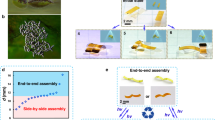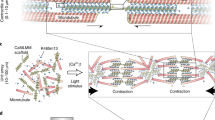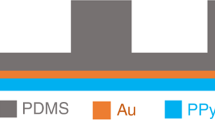Abstract
Polymeric microactuators are potentially useful in micromechanical systems and lab-on-a-chip systems. However, manufacturing of miniature polymeric actuators has been complicated owing to the necessity of including electrodes for actuation or using lithographic techniques for patterning. Here, we demonstrate that all-polymer microdevices can be fabricated using inkjet printing technology in combination with self-organizing liquid-crystal network actuators. We exploit the self-assembling properties of the liquid crystal to create large strain gradients, and light-driven actuation is chosen to allow simple and remote addressing. By using multiple inks, microactuators with different subunits are created that can be selectively addressed by changing the wavelength of the light. The actuators mimic the motion of natural cilia. These artificial cilia have the potential to create flow and mixing in wet environments such as lab-on-a-chip applications. The process is easily adapted for roll-to-roll fabrication, allowing for large-scale and low-cost production of miniaturized active polymer systems.
This is a preview of subscription content, access via your institution
Access options
Subscribe to this journal
Receive 12 print issues and online access
$259.00 per year
only $21.58 per issue
Buy this article
- Purchase on Springer Link
- Instant access to full article PDF
Prices may be subject to local taxes which are calculated during checkout






Similar content being viewed by others
References
Madden, J. D. W. et al. Artificial muscle technology: Physical principles and naval prospects. IEEE J. Ocean. Eng. 29, 706–727 (2004).
Mirfakhrai, T., Madden, J. D. W. & Baughman, R. H. Polymer artificial muscles. Mater. Today 10, 30–38 (2007).
Jager, E. W. H., Smela, E. & Inganas, O. Microfabricating conjugated polymer actuators. Science 290, 1540–1545 (2000).
Sekitani, T. et al. A large-area wireless power-transmission sheet using printed organic transistors and plastic MEMS switches. Nature Mater. 6, 413–417 (2007).
Küpfer, J. & Finkelmann, H. Nematic liquid single crystal elastomers. Macromol. Rapid Commun. 12, 717–726 (1991).
Finkelmann, H., Nishikawa, E., Pereira, G. G. & Warner, M. A new opto-mechanical effect in solids. Phys. Rev. Lett. 87, 015501 (2001).
Koerner, H., White, T. J., Tabiryan, N. V., Bunning, T. J. & Vaia, R. A. Photogenerating work from polymers. Mater. Today 11, 34–42 (2008).
Harris, K. D., Bastiaansen, C. W. M., Lub, J. & Broer, D. J. Self-assembled polymer films for controlled agent-driven motion. Nano Lett. 5, 1857–1860 (2005).
Tajbakhsh, A. R. & Terentjev, E. M. Spontaneous thermal expansion of nematic elastomers. Eur. Phys. J. E 6, 181–188 (2001).
Wermter, H. & Finkelmann, H. Liquid crystalline elastomers as artificial muscles. e-Polymers 013 (2001).
Thomsen, D. L. et al. Liquid crystal elastomers with mechanical properties of a muscle. Macromolecules 34, 5868–5875 (2001).
Yu, Y. L., Nakano, M. & Ikeda, T. Directed bending of a polymer film by light—miniaturizing a simple photomechanical system could expand its range of applications. Nature 425, 145 (2003).
Woltman, S. J., Jay, G. D. & Crawford, G. P. Liquid-crystal materials find a new order in biomedical applications. Nature Mater. 6, 929–938 (2007).
Den Toonder, J. et al. Artificial cilia for active micro-fluidic mixing. Lab Chip 8, 533–541 (2008).
Camacho-Lopez, M., Finkelmann, H., Palffy-Muhoray, P. & Shelley, M. Fast liquid-crystal elastomer swims into the dark. Nature Mater. 3, 307–310 (2004).
White, T. J. et al. A high frequency photodriven polymer oscillator. Soft Matter 4, 1796–1798 (2008).
Warner, M. & Mahadevan, L. Photoinduced deformations of beams, plates, and films. Phys. Rev. Lett. 92, 134302 (2004).
Broer, D. J. in Polymerisation Mechanisms Vol. 3 (eds Fouassier, J. P. & Rabek, J. F.) Ch. 12 (Elsevier Applied Science, 1993).
Van Oosten, C. L., Harris, K. D., Bastiaansen, C. W. M. & Broer, D. J. Glassy photomechanical liquid crystal network actuators for microscale devices. Eur. Phys. J. E. 23, 329–336 (2007).
Nie, Z. & Kumacheva, E. Patterning surfaces with functional polymers. Nature Mater. 7, 277–290 (2008).
Khatavkar, V. V., Anderson, P. D., Den Toonder, J. M. J. & Meijer, H. E. H. Active micromixer based on artificial cilia. Phys. Fluids 19, 083605 (2007).
Acknowledgements
This work was financially supported by the Dutch Polymer Institute under project # 532.
Author information
Authors and Affiliations
Contributions
C.W.M.B., C.L.v.O. and D.J.B. conceived and designed the experiments, C.L.v.O. carried out the experiments and wrote the article and all authors discussed the results and commented on the manuscript at all stages.
Corresponding author
Rights and permissions
About this article
Cite this article
van Oosten, C., Bastiaansen, C. & Broer, D. Printed artificial cilia from liquid-crystal network actuators modularly driven by light. Nature Mater 8, 677–682 (2009). https://doi.org/10.1038/nmat2487
Received:
Accepted:
Published:
Issue Date:
DOI: https://doi.org/10.1038/nmat2487
This article is cited by
-
Enabling liquid crystal elastomers with tunable actuation temperature
Nature Communications (2023)
-
Bi-enzymatic chemo-mechanical feedback loop for continuous self-sustained actuation of conducting polymers
Nature Communications (2023)
-
Polarization-driven reversible actuation in a photo-responsive polymer composite
Nature Communications (2023)
-
Bioinspired magnetic cilia: from materials to applications
Microsystems & Nanoengineering (2023)
-
4D Printing in Biomedical Engineering: a State-of-the-Art Review of Technologies, Biomaterials, and Application
Regenerative Engineering and Translational Medicine (2023)



